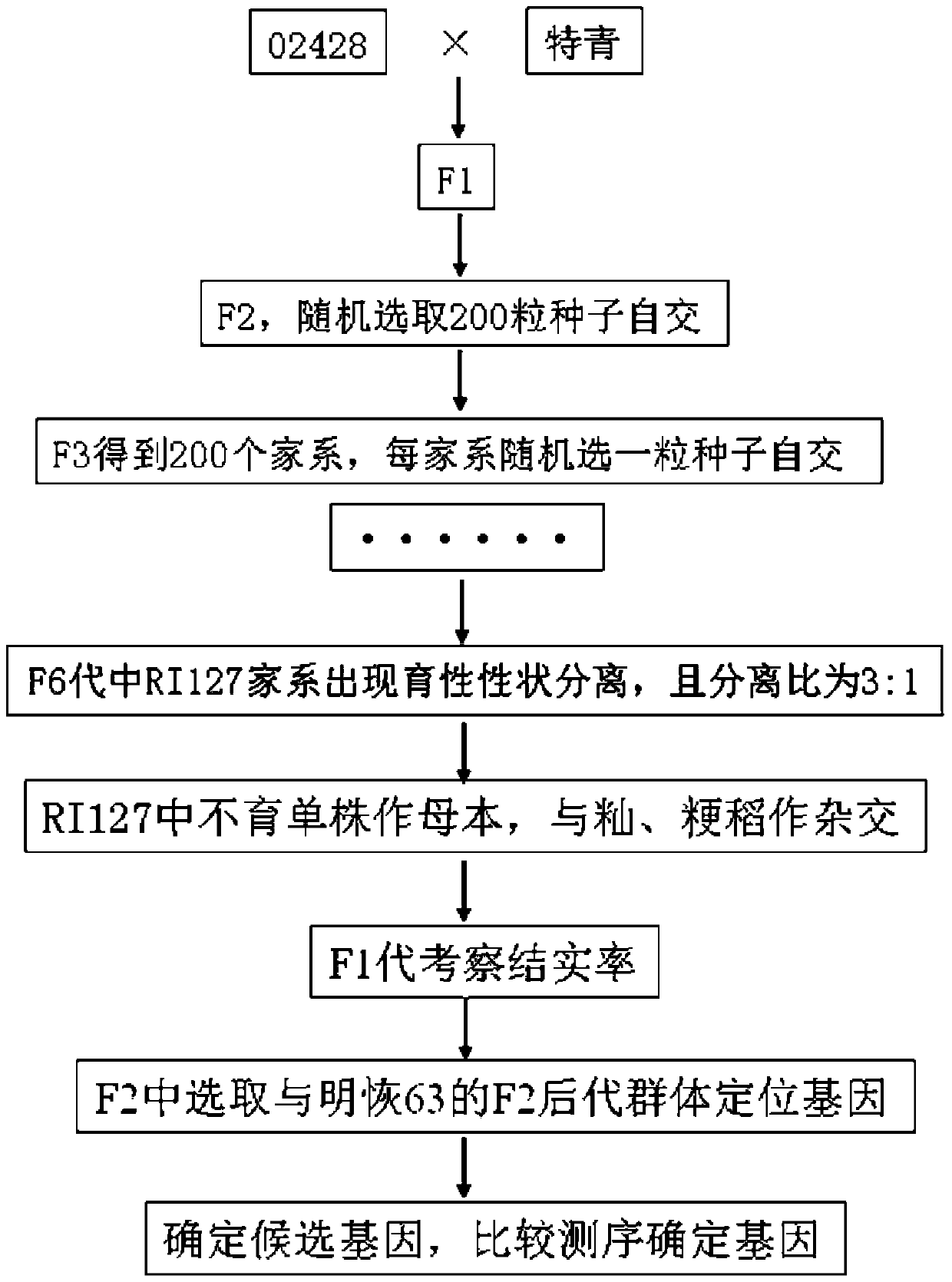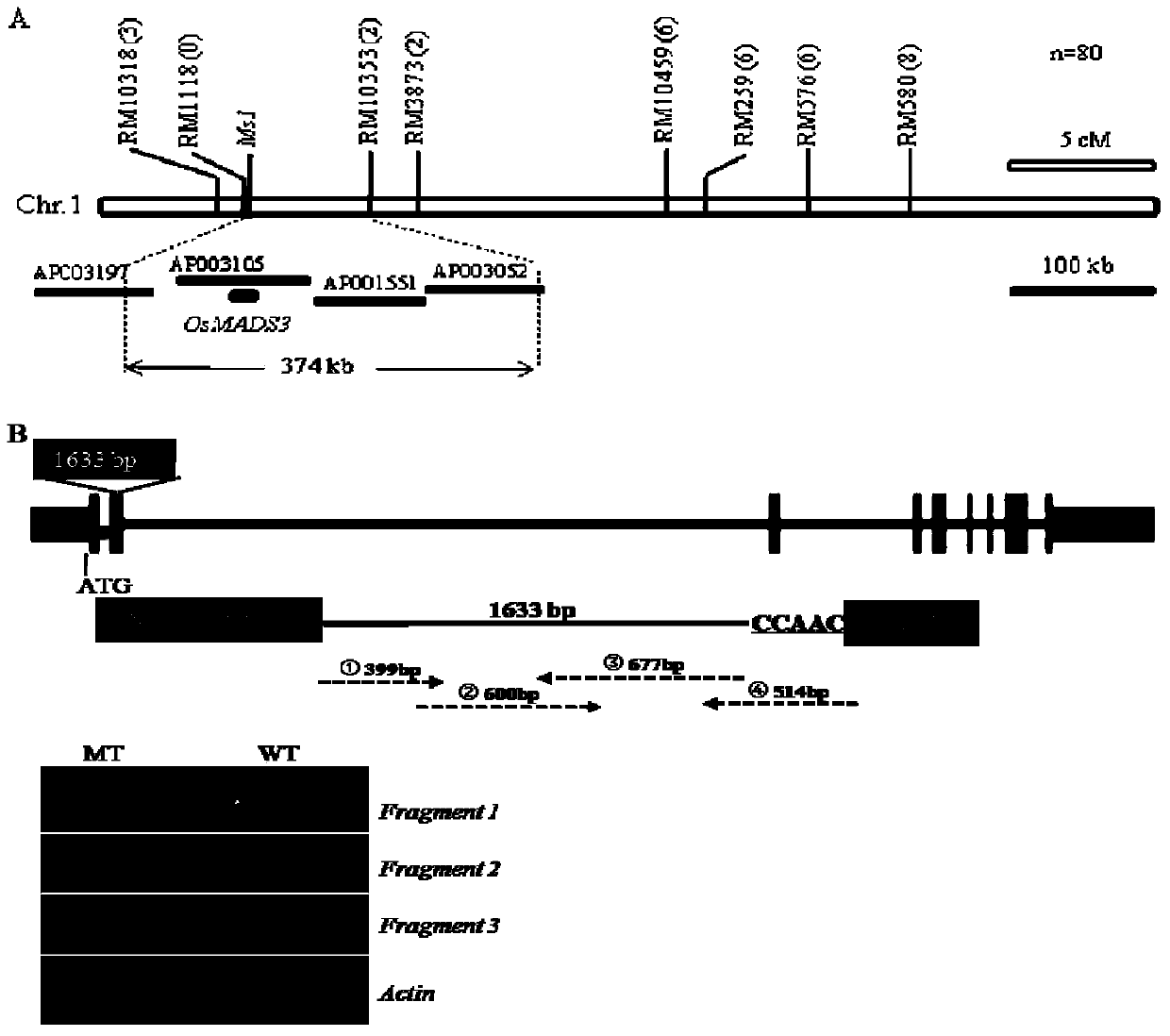Identification and utilization method of a broad-compatibility recessive sterile line in rice
A technique of recessive sterility and wide-breeding, which is applied in botany equipment and methods, biochemical equipment and methods, and microbial measurement/inspection, etc., and can solve problems such as poor flowering, high plant height, and low seed setting rate.
- Summary
- Abstract
- Description
- Claims
- Application Information
AI Technical Summary
Problems solved by technology
Method used
Image
Examples
Embodiment 1
[0035] Example 1: Constructing a recombinant inbred line and obtaining a sterile line.
[0036] according to figure 1 In the technical route shown, F 1 , using F 1 F 2 , from F 2 Randomly select 200 seeds in the middle, self-cross to get 200 families, choose 1 seed for each family to continue self-crossing, and get F 3 , also in F 3 In each family, one seed is self-crossed, and self-crossed to F 6 , 177 recombinant inbred lines (see figure 1 ), in which the 127th recombinant inbred line had a completely sterile mutant individual plant and a normal fertile individual plant, and their segregation ratio was 1:3; the sterile individual plant showed abnormal stamen development, and some stamens became pistil-like structure, or completely degenerated stamens. The genotype composition of RI127 was identified with 150 pairs of markers on the genome, and it was found that 55% of its genotype came from indica rice and 45% from japonica rice. At the same time, it was also foun...
Embodiment 2
[0077] Example 2: Map-based cloning of the male sterility gene.
[0078] Specific steps are as follows:
[0079] (1) Mapping population: cross the CMS line RI127S of mutant RI127 with the indica rice variety "MH63", and obtain F 2 The segregated population was used to map the male sterility gene. The investigation of field traits shows that the segregation ratio of sterile single plant: fertile single plant is 1:3, and the sterile single plant shows abnormal development of stamens, some stamens become a structure similar to pistils, or stamens are completely degenerated, such as Figure 4 shown.
[0080] (2) Total DNA extraction of rice: DNA extraction method refers to CTAB method (see Zhang et al., genetic diversity and differentiation of indica and japonica rice detected by RFLP analysis, 1992, TheorAppl Genet, 83, 495-499).
[0081] (3) Bulked segregant analysis (bulked segregant analysis) to locate target genes: Randomly select 120 (10 on each chromosome) SSR markers on...
Embodiment 3
[0095] Example 3 Obtaining Insertion Sequence and Verification of Genotype Identification by Gene Internal Markers
[0096] (1) Obtaining the insertion sequence
[0097] Using the total DNA of a single sterile rice plant RI127S as a template, TAIL-PCR amplification was performed, sequenced, and the insertion sequence was isolated. The specific method of TAIL-PCR is as follows: firstly, primary PCR is used, the total volume of the system is 20 μl: total DNA 40ng, 10×PCR buffer 2μl, 2mM dNTP 1.5μl, 25mMMg 2+ 1.5 μl, 10 μM specific primer (specific primer) 10.3 μl, 100 μM AD primer AD2a (primer) 0.2 μl, rTaq enzyme 0.1 μl, add double distilled water to 20 μl.
[0098] Reaction program: 94°C 5min; (94°C 30sec; 62°C 1min; 72°C 2.5min) × 5cycles; 94°C 30sec; 25°C 2min; 72°C (32% ramp), 2.5min; (94°C 20sec; 65°C 1min; 72℃2.5min; 94℃20sec; 65℃1min; 72℃2.5min; 94℃20sec; 45℃1min; 72℃2.5min)×15cycles; 72℃7min; 25℃10min. Then Secondary PCR, the total volume of the system is 20μl: the l...
PUM
 Login to View More
Login to View More Abstract
Description
Claims
Application Information
 Login to View More
Login to View More - R&D
- Intellectual Property
- Life Sciences
- Materials
- Tech Scout
- Unparalleled Data Quality
- Higher Quality Content
- 60% Fewer Hallucinations
Browse by: Latest US Patents, China's latest patents, Technical Efficacy Thesaurus, Application Domain, Technology Topic, Popular Technical Reports.
© 2025 PatSnap. All rights reserved.Legal|Privacy policy|Modern Slavery Act Transparency Statement|Sitemap|About US| Contact US: help@patsnap.com



